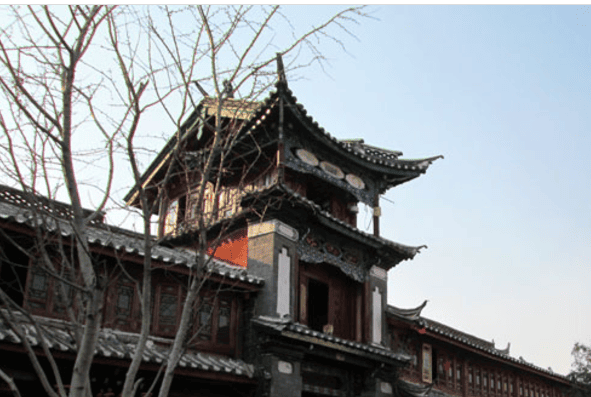The Ancient City of Lijiang

The Ancient City of Lijiang is located in the Yunnan Province, Southwest China. Situated at an altitude of 2,400 meters above sea level, the city spans 4 square kilometers. I arrived just before dusk after taking a morning train from Kunming. From the train station at that high altitude, the city of Lijiang appeared in the distance, surrounded by mountains, resembling a bowl nestled in the hills.
At the station, two young university students who lived in the Old Town area guided us. They were heading in the same direction and, with their friendliness, offered us a taxi. So, the four of us traveled toward the city, which took about 30 minutes. The taxi first dropped us off at the Old Town. Our accommodation was within the Old Town itself – an old house, typical of the local ethnic style, converted into a guesthouse called Panba Guesthouse. Upon arrival, it was drizzling, making the temperature even colder.
I hurried to my room on the second floor, feeling chilly and a bit tired after the long journey from Kunming. The bed was equipped with an electric blanket, which provided warmth without the risk of electric shock. The drizzle continued into the night, so I spent the evening at the guesthouse, sinking into the bed and embracing the warmth of the blanket. The next morning, I woke up feeling refreshed and started to explore the Ancient City of Lijiang.

I wandered along narrow stone streets, flanked by old traditional houses, many of which had been converted into guesthouses, hotels, and souvenir shops. The houses, mostly two-story, feature architecture from the Han and Tang Dynasties. As I observed, I occasionally crossed paths with the locals. Children were heading to school, and adults were going to work. Lijiang is home to several ethnic minorities, including Naxi, Sui, Pumi, Han, Bai, Yi, and Tibetans. The Naxi people, who make up about 70% of the population, are the most dominant.
The Naxi people have long developed their own unique culture, known as the Dongba culture, which is stored in the Dongba religion of the Naxi ethnic group. Dongba culture includes the Dongba script, Dongba scriptures, Dongba paintings, Dongba music, dances, and various ritual ceremonies.
The Naxi and other ethnic groups have created a brilliant culture, evident in the city’s streets, gates, rivers, bridges, and homes. This culture is still strongly present in the Ancient City of Lijiang to this day. I explored the city, from the westernmost edge of the Old Town to the eastern end at the Square Center Old Town, which is the main tourist area. I spent much of my time here, enjoying the atmosphere.

In this area, there is a wall that designates Lijiang as a UNESCO World Heritage City. There’s also a large waterwheel and a bridge, where local girls in traditional clothing wait for tourists to take photos with them for a fee. Nearby, there are Lijiang cowboys with their horses, also waiting for tourists, near the Love Lock area.

From this area, one can see old houses cascading down the hills. I explored the homes on the hills and discovered blooming cherry blossoms. In the evening, I revisited the rows of old houses, most of which had been transformed into souvenir shops. As the epicenter of the tourist area, this part of the city was bustling with restaurants, cafes, and pubs. The loud music from one of the popular cafes, Reggae Bar, caught my attention. But I decided to move on, as it was crowded and felt a bit too suffocating.
A Brief History of the Ancient City of Lijiang

The Ancient City of Lijiang has a history of over 800 years. It was founded at the end of the 12th century. From its inception, Lijiang has stood out from other inland Chinese cities. Unlike other cities, Lijiang does not have towering walls or gates. The city’s buildings and streets remain as they were when they were first constructed.
The city’s irregular street network and buildings, designed to follow the natural geography and terrain, contribute to the city’s liveliness and harmony. This style is rare among ancient Chinese cities. Lijiang is known as the “City of Water and Water City.” The Heilongtan Lake to the north of the city is the primary source of water for Lijiang.
Water from Heilongtan flows from north to south, meandering through the city and creating numerous small streams that wind through the walls of houses and cross streets and alleyways. This has created a distinctive water network that passes through streets, alleys, and buildings. There are 354 stone and wooden bridges across the canals, a number unmatched by any other ancient city in China.
All of these features contributed to the city’s designation as a UNESCO World Heritage Site in 1997. Since then, it has attracted many tourists who come to enjoy its unique beauty. I spent two days and three nights in the city, thoroughly enjoying the area. However, when it came to meals, I preferred to venture outside the walled Old Town.
Finding Halal Food

Although Lijiang is in a communist country with a population where Muslims are rare, finding halal food is not difficult. Outside the Old Town, along the main road, I discovered a Muslim-owned restaurant. I found it by chance while searching for breakfast. I saw a sign painted black with a mosque tower symbol.
At the front of the shop, smoked preserved meats were hung, but the small eatery only served noodle soup with meat. It was delicious, especially when enjoyed warm on a chilly day. The walls of the restaurant were decorated with photos of a mosque. I gestured to ask where the mosque was, and the owner, wearing a cap, pointed eastward. I was a bit confused!
After discovering this noodle shop, I made it my regular spot for meals during my stay in Lijiang. So, there’s no need to worry about traveling to areas where Muslims are few.
